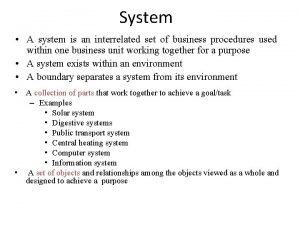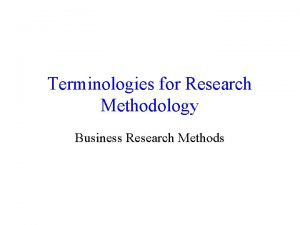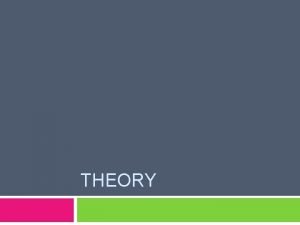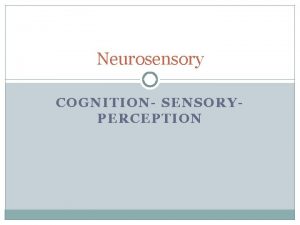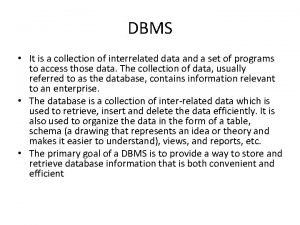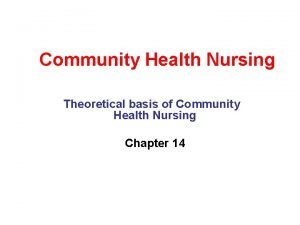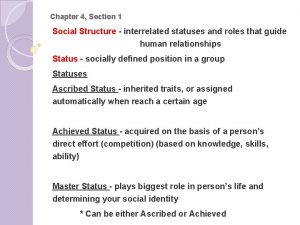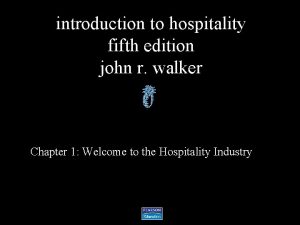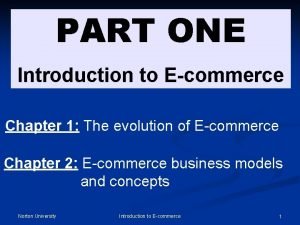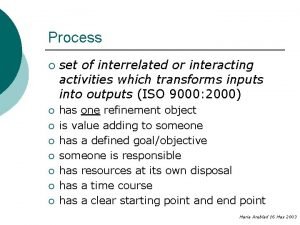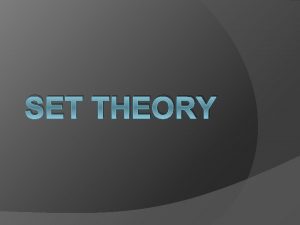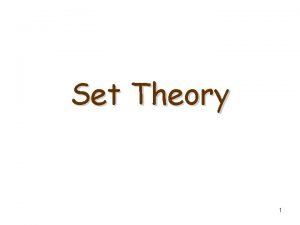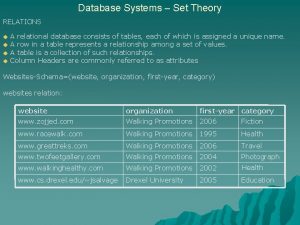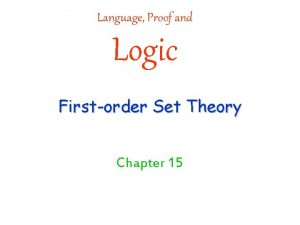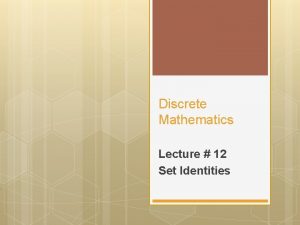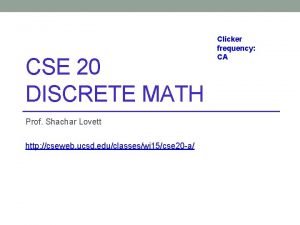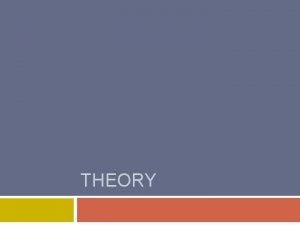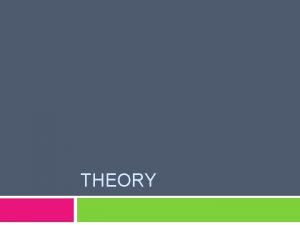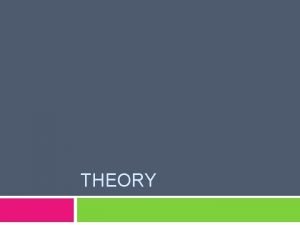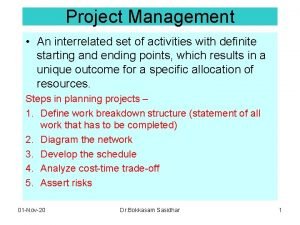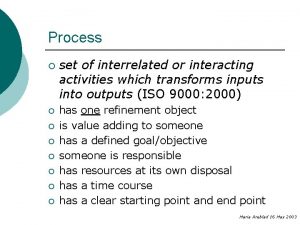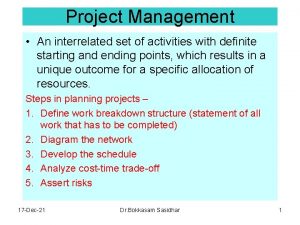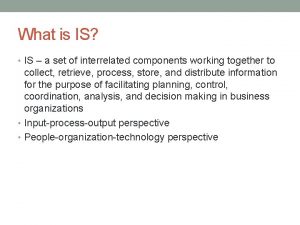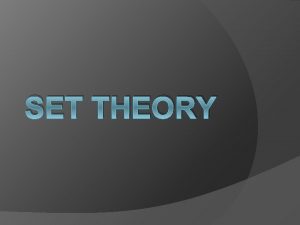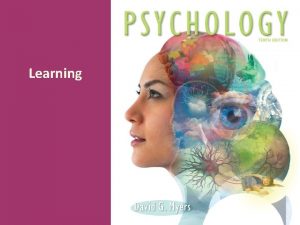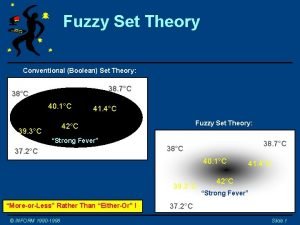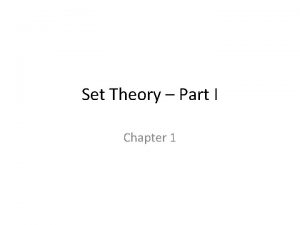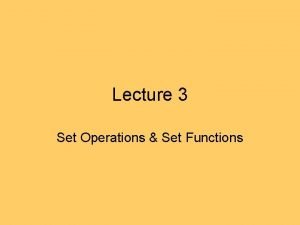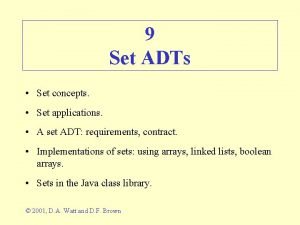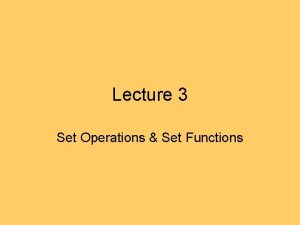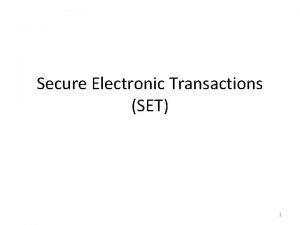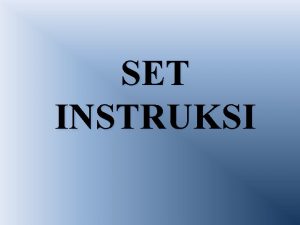THEORY What is theory a set of interrelated




























- Slides: 28

THEORY

What is theory? “… a set of interrelated concepts, definitions, and propositions that presents a systematic view of events or situations by specifying relationships among variables in order to explain and predict the events or the situations. ” § (Glanz, Rimer, and Lewis, p. 25)

Concepts & Constructs Concepts: Major ideas Constructs: Concepts that have been developed and defined for use in a particular theory

The Ecological Model Emphasizes the links and relationships among multiple factors (or determinants) affecting health

Ecological Model Public Policy Community Institutional or Organizational Interpersonal Individual

Ecological Model Concept Definition Intrapersonal Factors Individual characteristics that influence behavior, such as knowledge, attitudes, beliefs, and personality traits. Interpersonal Factors Interpersonal processes, and primary groups including family, friends, peers, that provide social identity, support, and role definition. Institutional/Organizational Factors Rules, regulations, policies, and informal structures, which may constrain or promote recommended behaviors. Community Factors Social networks and norms, or standards, which exist as formal or informal among individuals, groups, and organizations. Public Policy Local, state, federal policies and laws that regulate or support healthy actions and practices for disease prevention, early detection, control, and management. NIH, Theory at a Glance

Behavior Change Theories The specific route(s) you will take to reach your destination – they suggest a road to follow.

Behavior change theories with individual focus The Health Belief Model (HBM) ** The Transtheoretical Model (TTM) ** Theory of Planned Behavior (TPB) ** Other Theories: Elaboration Likelihood Model of Persausion Information – Motivation – Behavioral Skills Model Health Action Process Approach

Health Belief Model (HBM) Developed in the early 1950’s by social psychologists in the U. S. Public Health Service. Hochbaum & Rosenstock TB screening

Health Belief Model Modifying Factors: age, race, ethnicity, SES, personality Perceived Susceptibility & Perceived Seriousness Perceived Threat Cues to Action Outcome Expectations: Perceived Benefits vs. Perceived Risks/Barriers Likelihood of taking recommended action Self-efficacy

Health Belief Model 45 y/o Caucasian male, married, 2 children, works fulltime, desk job, does not seek health information Strong family history of heart disease / strokes; feels it could “happen to him” and ultimately lead to serious disability/death Perceived Threat Doctor diagnosed him as hypertensive, started on medication Outcome Expectations: Perceived benefits: no HTN medication, delay or prevent heart disease/stroke, live longer, better quality life. Perceived barriers/risks: time, money, injury? Likelihood of taking recommended action Self-efficacy: moderate

Health Belief Model Construct Definition Application Perceived Susceptibility One’s opinion of chances of getting a condition. Personalize risk based on a person’s feature or behavior; heighten perceived susceptibility if low. Perceived Severity One’s opinion of how serious a condition and its effects are. Specify consequences of the risk and the condition. Perceived Benefits One’s opinion of the efficacy of the advised action to reduce risk / seriousness of impact. Define action to take; how, where, when; clarify the positive effects to be expected. Perceived Barriers One’s opinion of the tangible and psychological costs of the advised action. Identify and reduce barriers through reassurance, incentives, assistance. Cues to Action Strategies to activate “readiness” Provide how-to information, promote awareness, reminders. Self-Efficacy Confidence in one’s ability to take action. Provide training, guidance in performing action. NIH, Theory at a Glance

Theory of Planned Behavior (TPB) Developed by Fishbein & Ajzen An extension of the Theory of Reasoned Action (TRA)

TPB Attitude toward the behavior Intention Behavior Subjective Norm Perceived Behavioral Control Actual Behavioral Control

TPB Healthy eating takes time, extra money and a lot of energy Friends / family do not exercise and junk food is always abundant “Not much I can do” Intention Eating healthier/ exercise Nearby grocery stores often have good sales, lives near farmer’s market. Lives near park and walking trails

Theory of Planned Behavior Construct Definition Application / Approach Behavioral Intention Perceived likelihood of performing behavior Are you likely or unlikely to perform the behavior? Attitude Personal evaluation of the behavior Do you see the behavior as good, neutral or bad? Subjective Norm Beliefs about whether key Do you agree or disagree that most people approve or people approve of/disapprove of the behavior; behavior? motivation to behave in a way that gains their approval Perceived Behavioral Control Belief that one has, and can exercise, control over performing the behavior NIH, Theory at a Glance Do you believe performing the behavior is up to you, or not up to you?

Transtheoretical Model (TTM) AKA: Stages of Change Developed by Prochaska & Di. Clemente Major Constructs: Precontemplation Contemplation Preparation Action Maintenance Decisional Balance Self-Efficacy

Precontemplation Transtheoretical Model (TTM) Decisional Balance Contemplation cy a c i ff f-E Sel Preparation Between every stage, the client needs to have decisional balance and self-efficacy Decisional Balance Action Maintenance acy Sel fic f-Ef

Stages of Change (TTM) Construct Definition Application Precontemplation Unaware of problem, hasn’t thought about change. Increase awareness of need for change, personalize information on risks and benefits. Contemplation Thinking about change in the near future. Motivate, encourage to make specific plans. Preparation Making a plan to change. Assist in developing concrete action plans, setting gradual goals. Action Implementation of specific action Assist with feedback, problem plan. solving, social support, reinforcement. Maintenance Continuation of desirable actions, or repeating periodic recommended step(s) NIH, Theory at a Glance Assist in coping, reminders, finding alternatives, avoiding relapses Groups with this theory: don’t forget a relapse plan!

Behavior change theories with interpersonal focus Social Cognitive Theory (SCT) ** Social Network Theory (SNT) Social Capital Theory

Social Cognitive Theory (SCT) A behavior change theory with an Interpersonal / Social network focus.

Reciprocal Determinism Characteristics of the Person Environment in which the behavior is performed Behavior of the person

Social Cognitive Theory Construct Definition Application Reciprocal Determinism Behavior changes result from interaction between person and environment Involve the individual and relevant others; work to change the environment, if warranted. Behavioral Capacity Knowledge and skills to influence behavior Provide information and training about action. Expectations Beliefs about likely results of action Incorporate information about likely results of action in advice. Self-Efficacy Confidence in ability to take action and persist in the action Point out strengths; use persuasion and encouragement; approach behavior change in small steps. Observational Learning Beliefs based on observing Point out others’ experience, others like self and/or visible physical changes; identify role physical results models to emulate. Reinforcement Responses to a person’s behavior that increase or decrease the chances of recurrence NIH, Theory at a Glance Provide incentives, rewards, praise; encourage self-reward; decrease possibility of negative responses that deter positive changes.

Summary of Theories Theory Focus Key Concepts Health Belief Model Individuals’ perceptions of the threat posed by a health problem, the benefits of avoiding the threat, and factors influencing the decision to act. Perceived susceptibility Perceived severity Perceived benefits/barriers Cues to action Self-Efficacy Transtheoretic Individuals’ motivation and al Model readiness to change a problem behavior. Pre-contemplation Contemplation Preparation Action Maintenance Theory of Planned Behavioral intention Attitude Subjective norm Perceived behavioral control NIH, Theory at a Glance Individuals’ attitudes toward a behavior, perceptions of norms, and beliefs about the ease or difficulty of changing.

Summary of Theories continued Theory Focus Key Concepts Social Cognitive Theory Personal factors, environmental factors, and human behavior exert influence on each other. Reciprocal determinism Behavioral capacity Expectations Self-efficacy Observational learning Reinforcements Diffusion of Innovations Theory How new ideas, products, and practices spread within a society or form one society to another. Relative advantage Compatibility Complexity Trialability Observability NIH, Theory at a Glance

Writing Objectives start with the word “to” followed by an action verb. Specify a single, key action to be accomplished The Specifies a target date The What / how much When Avoids the How and Why Realistic and attainable

Objectives S: specific M: measurable A: attainable R: realistic T: timely

Examples of objectives To decrease soda intake by one soda a week and be soda free by June 1 st, 2017. To increase running distance 1 mile every week in order to run a marathon on August 31, 2017. To cook a new vegetable recipe once a week through June 30, 2017. To decrease texting-related car accidents among 16 -25 y/o 20% by December 31 st, 2020. To increase meningitis vaccines in in-coming freshmen to 80% by September 30 th, 2021.
 Total set awareness set consideration set
Total set awareness set consideration set Training set validation set test set
Training set validation set test set Interrelated components meaning
Interrelated components meaning System is a set of interrelated subsystems.
System is a set of interrelated subsystems. A set of systematically interrelated concepts
A set of systematically interrelated concepts Examples of reciprocal determinism
Examples of reciprocal determinism Bounded set vs centered set
Bounded set vs centered set Fucntions
Fucntions Crisp set vs fuzzy set
Crisp set vs fuzzy set Crisp set vs fuzzy set
Crisp set vs fuzzy set What is the overlap of data set 1 and data set 2?
What is the overlap of data set 1 and data set 2? Correspondence function examples
Correspondence function examples Interrelated concepts nursing
Interrelated concepts nursing A collection of interrelated records is called a
A collection of interrelated records is called a Community oriented nursing definition
Community oriented nursing definition How are structures interrelated to each other
How are structures interrelated to each other Interrelated nature of hospitality and tourism
Interrelated nature of hospitality and tourism Interrelated special education
Interrelated special education Introduction to ecommerce
Introduction to ecommerce Interrelated processes
Interrelated processes The pineapple tradition
The pineapple tradition Konsep dasar logika himpunan
Konsep dasar logika himpunan Set theory
Set theory Disjoint set
Disjoint set Empty
Empty Set theory functions
Set theory functions Set theory
Set theory Identity law discrete math
Identity law discrete math Set theory practice
Set theory practice


